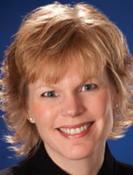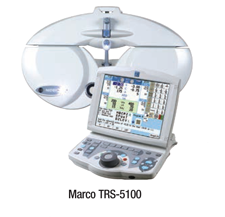

Dori Carlson, OD, FAAO, recalls walking through the exhibit hall at a Vision Source® national meeting in the early spring of 2012. She was nearing the end of her term as American Optometric Association president, which made her one of the most recognizable people in the hall. She and her husband, Mark Helgeson, OD, FAAO her partner in practices in Grafton and Park River, North Dakota, stopped by the Marco booth. David Marco saw her and called out to her, asking her what kind of autorefractor they were using in their offices. Dr. Carlson responded, saying, “We don’t have one. I have a retinoscope.”
The doctors had purchased plenty of high-technology diagnostic equipment to support their medical services: an optical coherence tomography unit, Optos technology, advanced visual field units and more. “We just hadn’t gotten around to upgrading the refracting system,” Dr. Carlson says. The return on investment for the purchase of an autorefraction system isn’t as easy to calculate as the return on equipment that generates charges or a higher level of medical billing.
Now nearly three years later, Dr. Carlson looks back and sees so many tangible and intangible benefits that resulted from adding the TRS-5100 autorefraction system.


One of the unexpected benefits is the physical relief that comes from using an autorefraction system. Dr. Carlson says that she feels less of the neck and back pain that she noticed when she was working with patients before. “I had hoped that would be the result, because I was starting to have aches and pains,” she says. The system sits on a console, and she can manipulate the process from a keyboard. “I don’t have to have my arms up and in front of me; this is more like I’m sitting at a desk.” Leaving the office without a crick in the neck or shoulders makes it easier to summon the energy to work out, something that she considers important for her mental health and stress relief.
Another advantage to the system is that every patient benefits. When a practice brings in high-technology equipment in order to monitor disease progression, for example, typically only a limited number of patients see that practice enhancement. But just about every patient who comes through the practice now experiences the high-tech autorefraction. “My patients are commenting constantly on the system,” says Dr. Carlson. They tell her that even though they know her office is modern, the refracting technology really hadn’t changed since they were kids. “But this is a technology touchpoint with everyone.”
Dr. Carlson says that she believes the system has been a factor in increasing per-patient revenue. “In part, that’s because the technology allows me to show people the changes in their Rx with a push of a button. Now I can say, ‘Here’s what you came in with, and here’s what I can do for you today.’ When I had to hold lenses over their eyeglasses, it was much more difficult to show how even minor shifts could have an impact on their overall vision.” The practice has seen an increase in patients buying new eyewear, even with subtle prescription changes.
The second contributing factor is that the testing process doesn’t take as long. “I have more time to talk with patients about what they need and want, so I can make more appropriate recommendations and explain what the benefits are of better products.”
About a year after adding the TRS-5100 to one office, the doctors added Marco’s EPIC system in the second. The additions have empowered the staff by allowing them to do more with patients. “I overhear them sometimes talking to patients about what the technology can do. It’s a point of pride with them.” In the office with the TRS, technicians conduct all the pretesting and transfer the data to the TRS console in the exam room via a credit card-sized card, and Dr. Carlson completes the refracting process with the patient. “Typically, finalizing the refraction now saves me several minutes per patient. In the office with the EPIC system, technicians complete the refraction prior to the doctor seeing the patient. Both ways of performing the refractions allow extra time to talk about lens choices and visual needs.”
Patients have noticed the difference, she says. “Refractions can be stressful. Patients have anxieties about giving the right answers, and we always worry when we have a patient who fatigues easily, wondering how accurate the measurements are. With the Marco system, we can complete the refraction accurately in less time. It’s much easier for the patients,” she says. And the results have been better. She recalls one patient, a woman in her 80s whom Dr. Carlson saw prior to adding the Marco system. “I couldn’t get her to see better than 20/50. I looked at everything and was really stuck. I even sent her to a retinal specialist,” she says. The following year, the patient returned, and Dr. Carlson completed the refraction with the TRS-5100. “The prescription was such a big change, both in cylinder and axis changes, but I decided to trust the technology. Sure enough, we got her seeing 20/25—and that sold me right there.”



